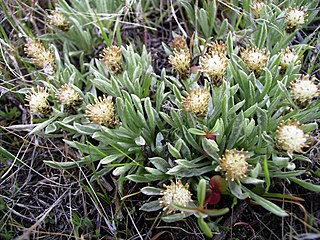
Antennaria is a genus of dioecious perennial herbs in the family Asteraceae, native to temperate regions of the Northern Hemisphere, with a few species in temperate southern South America; the highest species diversity is in North America. Common names include catsfoot or cat's-foot, pussytoes and everlasting.

Antennaria dioica is a Eurasian and North American species of flowering plant in the family Asteraceae. It is a perennial herb found in cool northern and mountainous regions of Europe and northern Asia (Russia, Mongolia, Japan, Kazakhstan, China, and also in North America.

Antennaria howellii, the everlasting or Howell's pussytoes, is a North American species of plant in the family Asteraceae. It is native to northern Alaska, much of Canada including the Arctic territories, and the northern United States as far south as northern California, Colorado and North Carolina.

Ambrosia eriocentra is a North American species of ragweed known by the common names woolly bursage and woollyfruit burr ragweed.

Antennaria argentea is a North American species of flowering plants in the family Asteraceae known by the common name silver pussytoes or silvery everlasting. It is native primarily to Oregon and to northern and central California with additional populations in Nevada, Idaho, Montana, and Washington.

Antennaria corymbosa is a North American species of flowering plants in the family Asteraceae known by the common names flat-top pussytoes or meadow pussytoes. It is native to western Canada and the Western United States south as far as Tulare County in California and Rio Arriba County in New Mexico. It grows in moist, cool areas such as mountain meadows and riverbanks. Most of the populations are found in the Rocky Mountains, the Cascades, and the Sierra Nevada.

Antennaria dimorpha is a North American species of flowering plants in the family Asteraceae known by the common names low pussytoes or gray cushion pussytoes. It is native to western Canada and the western United States as far south as Riverside County in California and Rio Arriba County in New Mexico. It is generally found in dry areas. There are historical records of the species formerly occurring in northwestern Nebraska, but these populations appear now to be gone.

Antennaria flagellaris is a North American species of flowering plant in the family Asteraceae known by the common names whip pussytoes and stoloniferous pussytoes. It is native primarily to the Great Basin and Columbia Plateau regions of Washington, Oregon, Idaho, and northern Nevada, where it is a member of the sagebrush scrub plant community. Additional populations are found in northeastern California, Wyoming, the Black Hills of South Dakota, and the Canadian Province of British Columbia.

Antennaria luzuloides is a North American species of flowering plant in the family Asteraceae known by the common name rush pussytoes. The species is native to western Canada and the western United States.

Antennaria media is a North American species of flowering plants in the family Asteraceae known by the common name Rocky Mountain pussytoes. It is native to western Canada and the Western United States from Alaska and Yukon Territory to California to New Mexico. It grows in cold Arctic and alpine regions, either at high latitudes in the Arctic or at high elevations in the mountains.

Antennaria pulchella is a North American species of flowering plants in the family Asteraceae known by the common names Sierra pussytoes and beautiful pussytoes. It is native primarily to high elevations in the Sierra Nevada from Nevada County to Tulare County, where it is a plant of the alpine climate. Additional populations occur on Lassen Peak in Lassen County, and also in Washoe County, Nevada.

Antennaria racemosa is a species of flowering plant in the family Asteraceae known by the common name racemose pussytoes. It is native to western North America from British Columbia and Alberta south as far as northern California and Wyoming. It grows in mountain forests, generally in moist, partially shaded areas, and often colonizes bare patches of mineral-rich soil, including disturbed areas.

Antennaria rosea is a North American species of flowering plant in the family Asteraceae known by the common name rosy pussytoes. Other common names include cat's foot and mountain everlasting. The second part of its scientific name, rosea, is Latin for pink.

Antennaria suffrutescens is a species of flowering plant in the family Asteraceae known by the common names evergreen pussytoes and evergreen everlasting. It is native to southwestern Oregon and far northeastern California. It grows in coniferous forests in the mountains, sometimes on serpentine soils.

Antennaria umbrinella is a North American species of flowering plants in the family Asteraceae known by the common names umber pussytoes and brown pussytoes. It is native to southwestern Canada and the western United States as far south as Colorado, Coconino County in Arizona, and Tulare County in California). It grows in a variety of habitats at a variety of elevations, from lowland sagebrush steppe to subalpine meadows.

Psilocarphus elatior is a species of flowering plant in the family Asteraceae known by the common names tall woollyheads, meadow woollyheads and tall woolly-marbles. It is native to the Pacific Northwest in western North America from Vancouver Island, where it is known from just a few occurrences, to northern California. It grows in seasonally moist spots such as meadows, spring seeps, and vernal pools.

Antennaria parvifolia is a species of flowering plant in the family Asteraceae, known by the common names small-leaf pussytoes and Nuttall's pussytoes. It is native to western and central North America.

Antennaria plantaginifolia is a perennial forb native to the eastern North America, that produces cream colored composite flowers in spring.

Antennaria lanata is a North American species of flowering plant in the family Asteraceae, known by the common name woolly pussytoes. It is native to western Canada and the northwestern United States.

Antennaria rosulata is a North American species of flowering plant in the family Asteraceae known by the common name Kaibab pussytoes or woolly pussytoes. It is native to the Southwestern United States, in the states of Arizona, New Mexico, Colorado, and Utah.





















